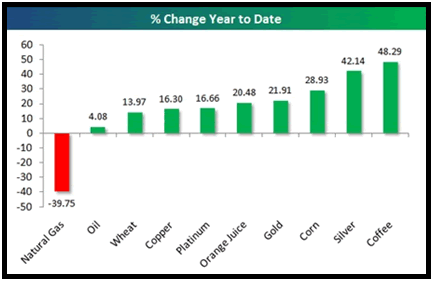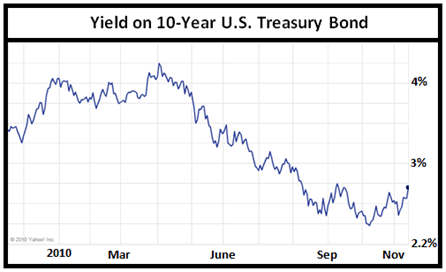Quantittaive Easing Ignites Real Price Inflation
Economics / Inflation Nov 16, 2010 - 02:57 AM GMTBy: Q1_Publishing
 The Federal Reserve’s moves are backfiring.
The Federal Reserve’s moves are backfiring.
The Fed’s recent announcement that it’s going to keep the free money spigot flowing for at least another six months was the last straw.
China, which has become a big lender to the U.S. to suppress its currency to make its goods cheaper, has criticized the move.
Germany, a large exporter who benefits greatly when the dollar rises against the Euro, has expressed concerns as well.
Now the program where the Fed buys bonds to push up bond prices and interest rates down with newly printed dollars is back in swing whether they like it or not.
As we’ve said throughout this unprecedented intervention in many past Prosperity Dispatches (Sign up here – It’s Free), there should be no expectation that the results will be any different this time.
The intended impact will never materialize. Consumers will continue to pay down debt as they deleverage. Unemployment will stay high.
The unintended consequences will become more magnified. And the profit potential of those unintended opportunities is only growing more magnified too.
The Real Inflation
The one big impact of Quantitative Easing has been price inflation.
Sure, the government tells us inflation isn’t a problem. This week they’ll keep telling us that. The Bureau of Labor Statistics is set to release the latest Consumer Price Index. It surely will be low. The annual rate of official inflation should be clock in around 1%.
They’re basically telling us, “Move along…no inflation here.”
Reality, however, is much different.
When the first round of Quantitative Easing was announced at the height of the credit crunch, we thought the outcome would be obvious.
Prices would decline for stuff there was already too much supply and for high-ticket items where demand wouldn’t be strong enough in a slow recovery (e.g. houses and big screen TVs). And prices for the stuff people want and need would climb higher.
The chart below from Bespoke Investment Group shows how the price of a lot of stuff is rising:

As you can see the prices for the stuff people want and need have soared. Life’s essentials and little luxuries like coffee, corn, orange juice, and wheat have all climbed. Stores of value like silver and gold have climbed as well.
Housing prices, meanwhile, have steadily fallen. Prices on TVs, electronics, washing machines, cars and other big-ticket items have stayed put or declined. In the case of TVs, a recent study revealed prices are expected to fall 8% while quality and features continue to improve.
This is the type of price inflation we expected and are seeing as a result from the Fed’s initial Quantitative Easing. There’s no reason to expect the results this time around to be any different. Many of those freshly printed dollars will inevitably flow to the high demand goods.
Bond Vigilantes Get Vigilant
The other consequence of the quantitative easing didn’t really hit hard the first time around. This time, however, the market has had enough.
The other big impact of this round of quantitative easing is already being felt. And it will present the biggest speed bump on the road to recovery – interest rates.
The entire recovery up to this point has been fueled by low interest rates.
Bond investors, however, may have ended the party. They have started selling and they started selling big.
The move has depressed the prices of the bonds. And interest rates, which move inversely to bond prices, have gone up.
The table below shows the yield on the 10-Year U.S. Treasury appears to have bottomed out and is back on the rise:

This is a change that can and will have far reaching consequences.
For example, a return to a normal yield would have a drastically negative impact on the housing market.
In Is Warren Buffett Wrong about the Housing Market we found:
The final major factor affecting housing prices is interest rates. Since most homes are bought with borrowed money, the interest amount portion of a homebuyers’ mortgage payment will vary greatly with interest rates…
[In our example of an “average” mortgage] a 3% increase in interest rates would result in a 36% increase in the monthly payment a buyer would have to pay. Prices must fall if rates rise.
The housing market has been on low rate life support since 2008. The Fed’s ability to keep long-term rates low has pushed mortgage rates at record lows. That’s all changing now as the bond investors have turned.
Rising rates are not good for stocks either. Low rates have pushed yield-chasing investors down the risk spectrum. Investor interest in high-yield junk bonds has exploded over the last two years. Investors have also turned to stocks to earn a decent return.
Higher rates will change all that. Fixed income investments of higher quality become more attractive as rates rise. Higher rates will pull a lot of investors back to fixed income and out of stocks.
Picking Your Spots
This, regrettably, is just a sign of the investment themes which are likely to dominate the foreseeable future.
An environment of rising inflation and interest is not a good one for stocks. We’re currently living in a fairly pleasant period where many of the new dollars pumped into the system has headed into stocks, bonds, and other financial assets.
Over the long run stocks will have big up and down moves. The micro-trends will last months at a time. We’ll be stuck with periodic recessions and slow growth and periods of extreme pessimism (everything in 2008) and extreme euphoria (stocks now). Then cycle through it all over again.
It is, however, good news for real assets. Savers and investors will move to protect the value of their savings. They will turn to precious metals and producers of energy, agriculture, and precious and base metals.
We continue to prepare for another lost decade just like the 1970’s. It won’t be exactly the same (The 70’s inflation was a demand-driven situation, this inflation will be a supply-driven), but the end results will likely be the same. And those investors that take advantage of the dips, scares, and occasional panics to get into extreme situations in the sectors destined to lead the way will do very, very well.
Good investing,
Andrew Mickey
Chief Investment Strategist, Q1 Publishing
Disclosure: Author currently holds a long position in Silvercorp Metals (SVM), physical silver, and no position in any of the other companies mentioned.
Q1 Publishing is committed to providing investors with well-researched, level-headed, no-nonsense, analysis and investment advice that will allow you to secure enduring wealth and independence.
© 2010 Copyright Q1 Publishing - All Rights Reserved
Disclaimer: The above is a matter of opinion provided for general information purposes only and is not intended as investment advice. Information and analysis above are derived from sources and utilising methods believed to be reliable, but we cannot accept responsibility for any losses you may incur as a result of this analysis. Individuals should consult with their personal financial advisors.
© 2005-2022 http://www.MarketOracle.co.uk - The Market Oracle is a FREE Daily Financial Markets Analysis & Forecasting online publication.



